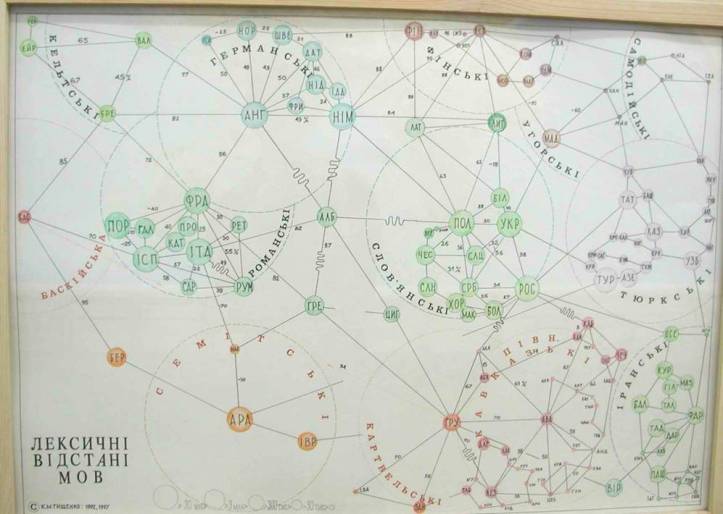How much does language change when it travels? How far are languages away from each other? How do they diverge?
Here a diagram I have come upon a couple of times on the net showing various lexical distances of most European languages. It is by Teresa Elms 2008.

Lexical Distance Among the Languages of Europe
It looks like a map of different cities connect by roads to each other, except instead of cities they are languages and instead of road distances, the lexical distances is shown.
The modern concept of measuring the distance between languages may have its starting point when French explorer Jules Dumont D’Urville compiled lists for various words Pacific island languages. He proposed a method for measuring the degree of relation among languages. The method to measure lexical distance is not uniform throughout the world but there are various proposals (see one here).
Teresa based her map on a diagram by Prof. Konstantin Tishchenko (Костянтин Тищенко published in Metatheory of Linguistics (you can read the book online here).

Diagram by Tyshchenko from 1997 which depicts languages spoken in Europe and their lexical distance.
Tyshchenko taught and researched linguistics at Kyiv Taras Shevchenko University and modelled and adjusted his 2D-matrix of languages and their relationship to each other. Even though the distances and angles of the 1997 version above are more accurate I would still like to share two earlier versions.
Professor Tyshchenko (centre) explains a lexical distance diagram to Norwegian Ambassador to Ukraine John Fredriksen Elvedal (left) during a 30 January 2013 visit to the Kiev Linguistic Museum. Diagram (right) shows languages spoken in Europe and their lexical distance and subdivisions coloured in.
 A hand drawn lexical distance map by Tyshchenko.
A hand drawn lexical distance map by Tyshchenko.
This version I find particularly beautiful because it also shows additional languages surrounding the Indo European family. It is all in Cyrillic so let me point out some of the additional languages that are missing in the other versions. Finnish and Estonian are joined by a few other Uralic languages with Hungarian placed further down and the Samoyedic languages bunched in the upper right corner with some connections to Turkic. In purple shades left of the green Slavic is Turkic, with Tat (Tatar), Kaз (Kazakh), Aзe (Azerbaijani) and Typ (Turkish) and many smaller bubbles. To the bottom centre in orange Semitic with Ара́ (Arabic), Івр (Hebrew) and linked to Italian a small Maltese is shown. Forever alone Бас (Basque) is a 70 lexical distance away from Spanish and in this diagram connected to Arabic over Бер which turns out to be Berber, also forever alone in North Africa. Then in darker orange, Kartvelian, with Гру (Georgian) Лаз (Laz). Kartvelian is shown as a half circle being part of Кавказькі (the Ibero-Caucasian languages) and іранські (Indo-Iranian) is squashed in the lower right corner. Armenian is noted as Вір and connected between these two branches.
Many of the smaller languages here are at risk of dying out and I have not found map by Tyshchenko with smallest Romance and Germanic languages. Never less, it is conspicuous and if you ever are lost in translation maybe this will help you out.
Edit: 26.05.2015
If you would like to read a relative recent Interview of Professor Kostiantyn Tyshchenko, then you can! Here originally published by the international edition of the Ukrainian Week on November 16 2012.
Edit: 20.08.2015
Fixed broken image links and added Picture of Professor Tyshchenko and Ambassador Elvedal.
[…] Fonte: Teresa Elms, 2008. Disponível em: https://alternativetransport.wordpress.com/2015/05/04/how-much-does-language-change-when-it-travels/ […]
LikeLike
Reblogged this on Odissey Rivne.
LikeLike
[…] Boban Arsenijevic tore the Lexical Distance Diagram apart and placed some fair critiques of it in the blog post “Lexical Distance Among the […]
LikeLike
Where is the “empty” arrow out of Hebrew going and why?
LikeLike
I can not answer that with certainty. Generally, a missing connector line does not mean there is no connection between those two languages, it just means the relationship was not researched. That broken connector line might imply or suggests some distant relationship Kartvelian.
LikeLike
I find this all very fascinating. I was wondering if you had another link to the last image (A hand drawn lexical distance map by Tyshchenko.) I’m really interested in seeing the relations among languages beyond Indo-European ones, but the image isn’t loading for some reason. Also, do you happen to know of anywhere else I could look to find out more about lexical distances among non-European languages (particularly interested in Asian ones)? Thanks!
LikeLike
So I fixed the image links. The last diagram also mostly includes Indo-European, Turkic, Semitic and Languages in the Caucasus. So technically also other languages in Asia, but nothing in the far east.
LikeLike
[…] found the lexical distance map fascinating but the closer I studied it the more things bothered me. Thus trawling through the net […]
LikeLike